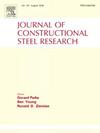冻融循环后SRC柱的轴压特性
IF 4
2区 工程技术
Q1 CONSTRUCTION & BUILDING TECHNOLOGY
引用次数: 0
摘要
本文研究了冻融循环对钢筋混凝土(SRC)柱轴压性能的影响。对28根SRC柱进行了冻融循环轴压试验。关键参数包括冻融循环次数、冻结介质、混凝土抗压强度、体积配箍比等。该研究使用数字图像相关技术(DIC)来捕捉轴向载荷下的破坏过程,研究了极限承载能力的退化、破坏机制和性能指标。确定了三种破坏模式:局部开裂、多裂缝发展和外保护混凝土层脱层。这些破坏模式受冻融循环次数和混凝土抗压强度的影响。极限载荷和刚度均显著降低,淡水条件下最大降幅分别为30.33%和75.82%,海水条件下最大降幅分别为36.75%和78.07%。虽然冻融循环后延性普遍下降,但由于破坏模式的改变,一些试件的延性有所增加。经过50次冻融循环后,淡水和海水条件下的性能退化差异可以忽略不计。然而,当循环次数达到100次时,海水暴露引起的极限载荷和刚度的降低都明显比淡水暴露引起的降低更为严重。基于试验结果和理论分析,建立了冻融循环后混凝土柱极限轴向承载力的预测方法,预测误差在10%以内。本文章由计算机程序翻译,如有差异,请以英文原文为准。
Axial Compressive Behavior of SRC Columns After Freeze-Thaw Cycles
This study investigates the impact of freeze-thaw cycles on the axial compressive behavior of steel-reinforced concrete (SRC) columns. Axial compression tests were conducted on twenty-eight SRC columns subjected to freeze-thaw cycles. Key parameters included the number of freeze-thaw cycles, freezing medium, compressive strength of concrete, and volumetric stirrup ratio. The study examined the degradation in ultimate load-bearing capacity, failure mechanisms, and performance indicators using Digital Image Correlation (DIC) to capture failure processes under axial loading. Three failure modes were identified: localized cracking, multi-crack development, and delamination of the outer protective concrete layer. These failure modes were found to be influenced by both the number of freeze-thaw cycles and the compressive strength of the concrete. Significant reductions in both ultimate load and stiffness were observed, with maximum decreases of 30.33 % and 75.82 % under freshwater conditions, and 36.75 % and 78.07 % under seawater conditions, respectively. Although ductility generally declined after freeze-thaw cycles, some specimens showed increased ductility due to altered failure modes. After 50 freeze-thaw cycles, the difference in performance degradation between freshwater and seawater conditions was negligible. However, once the number of cycles reached 100, the reduction in both ultimate load and stiffness caused by seawater exposure became significantly more severe than that caused by freshwater. Based on the experimental findings and theoretical analysis, a predictive method was developed to estimate the ultimate axial capacity of SRC columns after freeze-thaw cycles, achieving a prediction error within 10 %.
求助全文
通过发布文献求助,成功后即可免费获取论文全文。
去求助
来源期刊

Journal of Constructional Steel Research
工程技术-工程:土木
CiteScore
7.90
自引率
19.50%
发文量
550
审稿时长
46 days
期刊介绍:
The Journal of Constructional Steel Research provides an international forum for the presentation and discussion of the latest developments in structural steel research and their applications. It is aimed not only at researchers but also at those likely to be most affected by research results, i.e. designers and fabricators. Original papers of a high standard dealing with all aspects of steel research including theoretical and experimental research on elements, assemblages, connection and material properties are considered for publication.
 求助内容:
求助内容: 应助结果提醒方式:
应助结果提醒方式:


